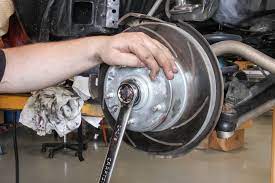Edwin is a writer who likes to write articles about investment and emerging industries. In addition, he also likes to share his daily life with cars on his blog. He has been writing for several years and enjoys sharing his knowledge with others.

As a mechanic, you already know how important it is to keep your vehicle in good condition. One of the critical parts of this is ensuring that the wheel bearings are in proper working condition. Wheel bearings play a vital role in your car’s performance, often going unnoticed until they start to fail. For this reason, it’s essential that you know how to replace the bearings when necessary.
In this post, we’ll outline some top tips that will help you to have a successful wheel bearing replacement.
Diagnosing the problem
The first step in any successful wheel bearing replacement is knowing what to look for. The most common symptoms of a failed wheel bearing include noise, vibration, and uneven tire wear. Another way to diagnose the problem is by lifting the car and wiggling the wheels to see if there is any play. Once you’ve identified the issue, it’s time to move on to replacing the bearings.
Picking the right replacement
Choosing the right bearing is critical to the success of the replacement. There are many types of bearings available, and it’s essential to pick the right one for your vehicle. Take into account not only the type and model of the car but also any specialized requirements that may be required. If you’re unsure of which bearing to choose, consult your owner’s manual or a trusted mechanic.
Tools and Equipment
Before you begin the replacement, be sure to have all the necessary equipment and tools. Some essential tools you’ll need include a bearing puller, a torque wrench, a breaker bar, and a jack stand. It’s also recommended to have a solution for lubrication, such as wheel bearing grease. A word of caution – don’t ever use a hammer to remove a bearing, as this could damage the wheel hub.
Get the Job Done Right
When starting the replacement, ensure that you’re working on a stable surface to avoid accidents. You should also use caution when dealing with heavy equipment and follow any recommended safety procedures. When fitting the new bearing, be sure to apply the correct torque settings for each bolt. Over-tightening bolts can cause excessive friction and, ultimately, failure of the new replacement.
Post-Replacement Checks
After the replacement has been successfully completed, it’s essential to test for proper operation thoroughly. Take the car for a test drive, listening carefully for any unusual noises, vibrations or other issues that may indicate the problem is not entirely resolved. If any issues arise, diagnose and fix them promptly.
Conclusion
Regular wheel bearing checks and timely replacements can help prevent costly repairs, making it crucial for vehicle owners and mechanics to know how to replace wheel bearings. With the right tools, equipment, and knowledge, replacing wheel bearings can be done easily and quickly, ensuring that your car runs smoothly and safely. Use these top tips to ensure that you have a successful wheel bearing replacement that will keep the car running at its best.
